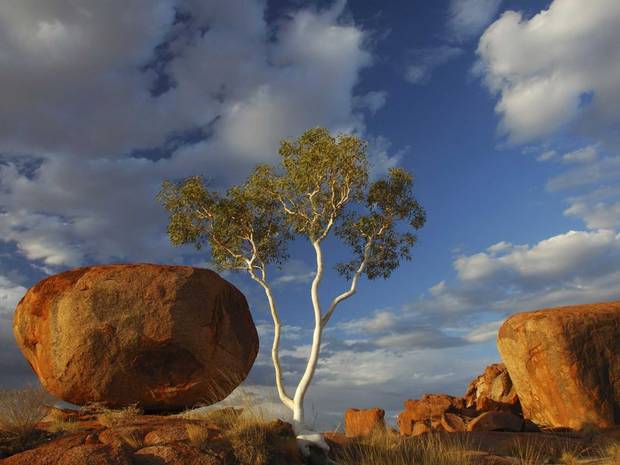Science News
Trees in Australia are Striking Gold
November 11, 2013

By Jami Smith
Scientists have discovered that minute gold particles found in the leaves of Eucalyptus trees may be an indication of gold deposits deep in the earth below. If they’re right, future fortune hunters might be able to use X-ray imaging, instead of destructive drilling, in their search for the precious metal.
Melvyn Lintern, of CSIRO Earth Science and Resource Engineering, and his colleagues have found that the Eucalyptus root system is unusually deep and extensive, with sinker roots in one species (Eucalyptus marginata) measuring 130 feet (nearly 40 meters). As the roots search for water in the arid Australian climate, they move deeper into the earth. That water, which contains microscopic particles of gold, then moves up the tree through its vascular system. The researchers found gold throughout the trees, but the highest concentrations were in the foliage.
According to Lintern and his colleagues in a study published recently in Nature Communications, “Gold is probably toxic to plants and is moved to its extremities (such as leaves) or in preferential zones within cells in order to reduce deleterious biochemical reaction.”
To prove that the gold came from the ground below the tree and not from dust particles, researchers used field samples from trees growing on known gold deposit sites. They compared those samples to leaves from sites with no known underground gold deposits and to greenhouse samples.
In one of the field tests at a site in southern Australia, Lintern’s group showed that Eucalyptus trees growing above a gold deposit situated 115 feet (35 meters) underground had 20 times more of the metal in their leaves than the trees growing 2,600 feet (800 meters) away.
The study further revealed, “…Samples from the large Eucalyptus trees at Freddo were found to be highly anomalous in Au [gold] exclusively and directly over the buried deposit,”
While there is not enough gold in these trees to warrant harvesting it, this discovery might save time and money in the future hunt for gold. Sample-collecting from the surface is much cheaper, faster and less damaging to the terrain than drilling holes.
And according to Australia’s ABC News, growing gold is not exclusive to Eucalyptus trees:
“We've actually found gold not only in trees but in shrubs that are growing beneath the trees as well, so (it is) not restricted to any particular trees at all,” Lintern says.
“Collectively, these results are important for mineral explorers to consider as they access more difficult terrains with deeper sediments and assess more subtle surficial geochemical anomalies,” the authors conclude.
Jami Smith is a science geek-wannabe and volunteers for Science Today.
Image: Wikimedia